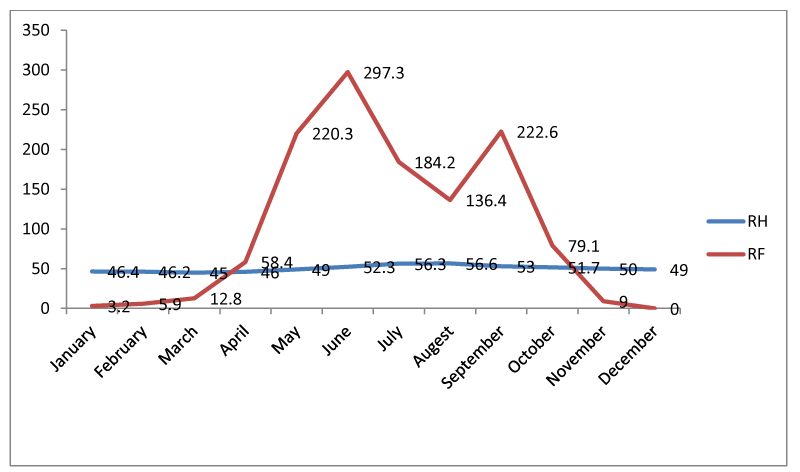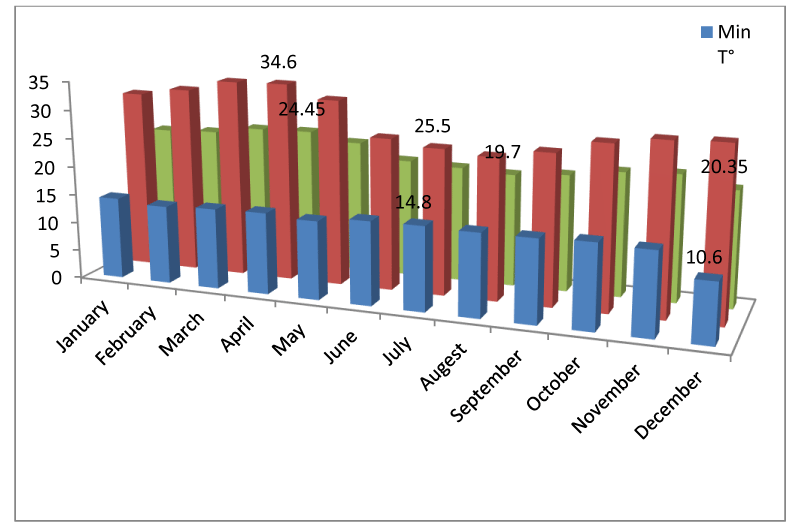Open Journal of Plant Science
Effect of sowing time and environmental variation on yield of differnt Maize varieties
Begizew Golla*, Birhanu Tadesse, Desalegn Chalsisa and Elsabet Bayisa
Cite this as
Golla B, Tadesse B, Chalsisa D, Bayisa E (2018) Effect of sowing time and environmental variation on yield of differnt Maize varieties. Open J Plant Sci 3(1): 041-045. DOI: 10.17352/ojps.000014The primary factors those influenced yield potential of maize crop are genotypes, environment and interaction between them. Thus Evaluation of different maize varieties under different environmental condition helps to select the superior one in its yield potential among treatments. To verify this fact the field experiment was conducted during rainy season with three planting times, at Bako and Uke in 2016. Planting times were designed with 7 days interval among each planting time for each location. The first planting was done in may 25/ 2016 and in may 27/2016 for Uke and Bako respectively. The experiment was laid out in a Randomized Complete Block Design with three replications. Twenty maize varieties were planted in uniform spacing of 75x30 cm to understand the influence of sowing time, location and varieties on grain yield of maize, and to selected suitable variety. The analysis of variance showed that a significant (P<0.01) effects of panting times and varieties on grain yield of maize. The maize variety BHQPY 545 was superior in grain yield (10445 kg/ha) and number of cobs (87161 cob/ha) at both locations and at all planting times. However statistically similar grain yield (9616.3kg/ha) was also obtained in another maize variety BH 546. But BHQPY 545 performed well in all location with similar input and management. Therefore BHQPY 545 is the most suitable and productive variety under these locations. Although the results are one year experiment the variety performed well at two locations and number of cobs per plant is genetic factor. Thus BHQPY 545 variety should be grown at Bako and Uke to produce high yield.
Introduction
Maize (Zea mays L) is one the most important cereal crop having quick growing nature, high yield capacity and wider adaptability over a range of environmental conditions (Patel et al., 2017). The worldwide significance of maize as human food, animal feed and as raw materials for the manufacture of different industrial products is increasingly expressed. In Ethiopia maize is one of the most strategic crops for food security. It is grown every year in wide cultivated land in diverse agro ecologies for various uses of human beings.
Maize cultivars are grown in diverse agro-climate condition of different soil types, soil fertility levels, moisture levels, temperatures, planting time and management practices. All these factors constitute the growing environment for the crop varieties during production period [1].
Good planting date is one of the crucial factors that strongly influence crop production in rain fed agriculture. Particularly in many parts of Africa where the rainy season starts with some light showers followed by dry spells, can cause poor crop emergence or desiccate a young crop. Ethiopia is frequently portrayed as a drought-stricken country. Abnormally low and infrequent rainfall has been increasing the frequency and impact of droughts [2]. So it is important to adjust planting time to reduce such impacts. In addition, maize is C4 plant, its yield potential is depends on the photo period, the daily temperature (degree day) and optimum rainfall. Thus a difference in time of planting is related to different climatic conditions (rainfall, temperature and photoperiod) [3]. Maize grows well in the most varied conditions but the interaction between the environments and its genotype and variety is crucial to its production [4].
Grain yield is highly influenced by genotype and environment interaction [5]. Therefore evaluation of cultivars in multiple environments is essential [6]. Crop yield and quality are the result of the interaction between a genotype’s potential expression and the environment, which is modified by agronomic management in order to meet the objectives of the farmer (Mariani et al., 2017). Therefore, much breeding and agronomic research has been designed to improve performance of crops under various agro climate conditions.
Optimizing of sowing date depend on the maturity stage is among the most important agronomic practices to increase crop production. High yielding varieties of maize are most sensitive to time of sowing; hence optimum time of sowing contributes more towards maize grain yield (Patel et al., 2017). It is therefore necessary to determine suitable planting time at different location to enhance productivity and production of maize in Ethiopia. Keeping this in view this study is designed with the following objective:
Objective
To identify the most suitable varieties and appropriate planting time for high yield of maize under different environments
Material and Methods
Twenty varieties (Table 1) were used for this experiment. The experiment was conducted at two locations (Bako and Uke) in 2016. The altitude of Bako is 1650 m. above sea level where as the altitude of Uke is 1200 above sea level. In both locations there was good rainfall distribution from May to November during 2016. Monthly rain fall distribution and relative humidity maximum temperature minimum temperature and mean temperature for Bako is indicted in the graphs 1,2 below.
Fertilizer: Nitrogen fertilizer in the form of urea (46% N) and NPS (19 %N, 38% P2O5, and 7 % S) fertilizers were used as a source of nitrogen and Phosphorus respectively
Treatments and experimental design
Three planting time were designed with 7 days interval among each other at both location. The first planting times were may 25/ 2016 and may 27/2016 for Uke and Bako respectively. All maize varieties were planted at 75cmx30cm spacing. The recommended rate of P fertilizer (100kg NPS) and half of the recommended of N fertilizer (100kg urea) was applied at sowing time and the remain half dose of urea (100 kg/ha) was applied 35 days after planting. The experiment was laid out as a randomized complete block design (RCBD) with three replications. The gross plot size was 4.5 m× 2.4 m (10.8 m2) with row length of 2.4 m, but net plot size 3m × 2.4 m (7.2 m2) was used for harvesting to minimize the border effects on the crop yields. The treatments were randomly assigned to the experimental unit within a block (replication). The blocks were separated by 1.5 m wide space.
Crop Data Collection: Data such as time of silking and tasseling, physiological maturing time, number of cobs and grain yield were collected and recorded for analysis.
Finally analyses of variances for the data recorded were conducted using the SAS version 9.3. Least significant difference (LSD) test at 5% probability was used for mean separation if the analysis of variance indicated the presence of significant treatment differences.
Result and Discussion
The combination analysis of variance revealed a significant (P<0.01) effects of panting times, en and entries on grain yield of maize. However, location and the interaction of panting times and location were not significant.
The maize variety BHQPY 545 was superior in grain yield (10445 kg/ha) and number of cobs (87161 cob/ha) at both locations and at all planting times. Therefore BHQPY 545 is the most suitable and productive variety under these locations. Although some varieties showed significantly similar effect with this variety their yield performance is not consistence across location and planting times (Tables 2,3). [7] Reported that the maize varieties with stable mean yield across environments should be used to increase maize production [8,9].
Phenological parameters of maize
The analysis of variance revealed a significant (P<0.01) effects of locations, planting time entry and interaction among them on phenological parameters.
The highest days to attain 50% tasseling, silking and physiological maturity days were recorded on BH-660 BH 661 and Mork while the shortest day to attain 50% tasseling, silking and physiological maturity were observed on Melkasa6Q, Melkasa4 and Melkasa2 varieties. This clearly indicated that Melkasa6Q, Melkasa4 and Melkasa2 varieties were earlier seceded of their function of photosynthesis resulting reduction in their grain yield. On other hand BH-660 BH 661 and Mork capture solar radiation for longest time. But their proliferation is limited to one cob per plant (Table 4).
Conclusion
Maize grain yield is highly affected by genotype and planting times. Planting time is also varied depends on agro ecologies. Maximum grain yield (191086 kg) was obtained when the maize varieties planted in June 3/2016 at Bako agro ecological condition. However, in case of another location (Uke) the maximum grain yield (172003kg) was obtained in the first planting time, may 25/2016.
The maize variety BHQPY 545 was superior in grain yield and number of cobs compared to all other varieties at both locations and at all planting times though statistically similar result was obtained on variety BH 546. Therefore BHQPY 545 is the most suitable and productive variety under these locations. Although the results are one year experiment the variety performs well at two locations and at three planting times. The crucial factor that enable the variety BHQPY 545 to be superior over other varieties is its ability to caries two or more than two cobs per plan. Number of cobs per plant is genetic factor which is seldom affected by environments. Thus BHQPY 545 variety should be grown in the first week of June at Bako and in the first days of the last week of May at Uke to produce high yield.
- Abdulai MS, Sallah PYK, Safo-Kantanka O (2007) Maize grain yield stability analysis in full season lowland maize in Ghana. Int J Agric Biol 9: 41-45.
- Gebrehiwot T, van der Veen A, Maathuis B (2011) Spatial and temporal assessment of drought in the Northern highlands of Ethiopia. International Journal of Applied Earth Observation and Geoinformation 13: 309-321. Link: https://goo.gl/L3exea
- Mas-ud M, Kaba JS, Ofori K, Salifu G (2016) Relative planting dates effect on the agronomic performance of Maize (Zea Mays L.) and Groundnut (Arachis Hypogea L) in an intercrop system. American Scientific Research Journal for Engineering, Technology, and Sciences (ASRJETS) 16: 262-276. Link: https://goo.gl/u2tmxs
- Otung IA (2014) Evaluation of six chinese maize (Zea Mays) Varieties in the humid tropical environment of calabar, South-East, Nigeria. Global Journal of Agricultural Research 2: 10-16. Link: https://goo.gl/6KN2bu
- Khalil IA, Rahman H, Rehman NU, Arif M, Khalil IH, et al. (2011) Evaluation of maize hybrids for grain yield stability in north-west of Pakistan. Sarhad J Agric 27: 213-218. Link: https://goo.gl/DjgQyb
- Fan XM, Kang MS, Chen H, Zhang Y, Tan J, et al. (2007) Yield stability of maize hybrids evaluated in multi-environment trials in Yunnan, China. Agronomy journal 99: 220-228. Link: https://goo.gl/3CJ5mZ
- Ngaboyisonga C, Nyombayire A, Gafishi MK, Nizeyimana F, Uwera A, et al. (2016) Adaptability and genotype by environment of maize commercial hybrid varieties from east african seed companies in rwandan environments. Global Journal of Agricultural Research 4: 32-40. Link: https://goo.gl/XRHf29
- Abate T, Shiferaw B, Menkir A, Wegary D, Kebede Y, et al. (2015) Factors that transformed maize productivity in Ethiopia. Food Security 7: 965-981. Link: https://goo.gl/Wjaxjh
- Worku M, Twumasi Afriyie S, Wolde L, Tadesse B, Demisie G, et al. (2012) Meeting the challenges of global climate change and food security through. Link: https://goo.gl/PbGNNf
Article Alerts
Subscribe to our articles alerts and stay tuned.
 This work is licensed under a Creative Commons Attribution 4.0 International License.
This work is licensed under a Creative Commons Attribution 4.0 International License.



 Save to Mendeley
Save to Mendeley
